List of 999 women of the Heritage Floor / Virginia Woolf
This list describes the place setting for Virginia Woolf on the table of Judy Chicago's art installation The Dinner Party . It is part of the list of 999 women on the Heritage Floor who are assigned to the respective place settings on the table. The names of the 999 women are on the tiles of the Heritage Floor, which is arranged below the table and belongs to the art installation.
description
The installation consists of a three-sided table, each with 13 historical or mythological personalities, thus a total of 39 people, from prehistory to the women's rights movement . These people were assigned a place setting at the table, consisting of an individually designed table runner, an individually designed plate, a goblet, knife, fork, spoon and serviette. The first page of the table is devoted to prehistory up to the Roman Empire , the second to Christianization up to the Reformation and the third from the American Revolution to the women's movement. Each place setting on the table is assigned additional personalities who have received an entry on the tiles of the Heritage Floor, which occupies the space under the table and the center of the space between the sides of the table. This list captures the personalities assigned to Virginia Woolf's place setting. Your seat is on the third side of the table.
Hints
In addition to the names as they are used in German transcription or in scientific usage, the list shows the spelling chosen by Judy Chicago on the tiles.
The information on women who do not yet have an article in the German-language Wikipedia is referenced by the individual references listed under comments . If individual information in the table is not referenced via the main article, additional individual references are given at the relevant point. If there are any discrepancies between the information provided in Wikipedia articles and the descriptions of the work of art on the Brooklyn Museum website , this will also be indicated under Comments.
Place setting for Virginia Woolf
Virginia Woolf was born on January 25, 1882 in London as Adeline Virginia Stephen as the daughter of the writer, historian, essayist, biographer and mountaineer Sir Leslie Stephen and his second wife Julia Prinsep Jackson. She had several siblings and half-siblings. Her psychological problems could be traced back to her half-brothers Gerald and George Duckworth , who abused Virginia or at least touched her immorally more often and thus set one of the triggers for her manic-depressive illness, which is now known as bipolar disorder . Virginia Stephen was tutored by a private tutor and her father, whose work impressed her so much that she too expressed her desire to become a writer at an early age. Her mother died when Virginia was thirteen and this led to her first mental breakdown. Her father died in 1904, which triggered her second episode of mental illness in Virginia, but it also meant a relief, as Virginia and her sister Vanessa had to run the household for the father after the death of their mother and older sister Stella.
She met her future husband, Leonard Woolf , at dinner with her brother Thoby, who had just started studying and was also a guest at Leonard Woolf, who was studying law. Woolf proposed marriage to her in January 1912. This triggered another episode of illness, but after four months of being in the hospital and Woolf was not allowed to visit her, she agreed. She described her marriage as happy even if there were difficulties. Leonard Woolf loved her and she had found an understanding and educated husband who saw her affectionate relationships with other women with serenity and who could bear her frigidity towards him.
Virginia Woolf worked as a writer and, with her husband, as a publisher. She made a name for herself early on as a literary critic and essayist . She made a name as a novelist with her novel The Voyage Out (The trip out) in 1915. In the 1970s, her work and Virginia Woolf were rediscovered when her essay A Room of One's Own ( A Room of One's Own ) from in 1929 became one of the most important texts of the women's movement . Already Ethel Smyth recognized in 1930 the importance of the work, when she asked Woolf, in a BBC program entitled Points of Views looked participate, and the essay as an important contribution to the emancipation movement.
The outbreak of the Second World War prompted the Woolfs to live in their Monk's House in the country and only visit the publishing house in London once a week. The publishing house was destroyed in an attack. Already at the beginning of the war they decided to voluntarily commit suicide when the Germans marched in, because Leonard Woolf was a Jew and a socialist. In the spring of 1941, Virginia feared another psychotic episode, and Leonard took her to a doctor friend in Brighton to discuss treatment options. The next day, March 28, 1941, she committed suicide in the River Ouse near Rodmell . Her body was not found until three weeks later.
For the table setting for Virginia Woolf on the dinner party, Judy Chicago chose an analogy to a blooming flower, with which she describes Woolf's advocacy for liberation from the boundaries of predominantly male-dominated literature, but also the powerful fertility of the early goddess plates the dinner party, which in the case of Woolf is supposed to express creative fertility. The plate is designed with a three-dimensional flower, in the center of which there are seed shapes. It stands on a table runner from which a sewn and painted beam of light shines out from under the plate, which alludes to her book To the Lighthouse . It symbolizes the charisma that Woolf's literary legacy has for other women in order to find a way to a new, female literary language. The table runner consists of a delicate chiffon fabric, which should be interpreted as an indication of the mental fragility of Woolf. The initial letter “V” on the front of the runner is in a wave pattern, which refers to her death by drowning, but also to her book The Waves .
| Surname | Spelling on the tile | Date of birth | cultural spatial assignment | Remarks | image |
|---|---|---|---|---|---|
| Adela Zamudio | Adela Zamudio-Ribero | 1854 | Bolivia | Teacher, writer, playwright and painter who also published her works under the pseudonym Soledad (loneliness). |
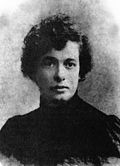
|
| Agnes Smedley | Agnes Smedley | 1892 | United States | Journalist and author best known for her articles and books on the Chinese Revolution . In 1920 she opened a family planning clinic in Berlin . |

|
| Alfonsina Storni | Alfonsina Storni | 1892 | Argentina | Poet and writer of the Argentine avant-garde . |

|
| Anaïs Nin | Anaïs Nin | 1903 | United States | Writer, author of diaries, novels and erotic stories with extremely explicitly described sexual acts. |

|
| Bertha Eckstein servant | Helen Diner | 1874 | Austria | Pseudonym Sir Galahad , was an Austrian writer and travel journalist. She wrote the first cultural history focused on women and is considered the founder of matriarchy research . |
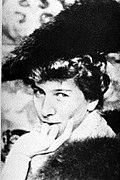
|
| Colette | Colette | 1873 | France | Writer, variety artist and journalist. She was the first woman in France to have a state funeral . |

|
| Doris Lessing | Doris Lessing | 1919 | United Kingdom | Writer. In 2007 she received the Nobel Prize in Literature . |

|
| Dorothy Richardson | Dorothy Richardson | 1873 | United Kingdom | She was the first English-language author who a novel in the narrative technique of stream of consciousness ( " stream of consciousness released"). | |
| Edith Sitwell | Edith Sitwell | 1887 | United Kingdom | Poet and critic. Her home was always open to the poetic circle of London, to which she was always generous and helpful. Sitwell published continuously from 1913 poems, some of which were abstract and set to music. |

|
| Edith Wharton | Edith Wharton | 1862 | United States | Writer and author of socially critical novels. |

|
| Edna St. Vincent Millay | Edna St. Vincent Millay | 1892 | United States | Poet and playwright and third woman to receive the Pulitzer Prize for Lyric Poetry. She was known for her unconventional and bohemian lifestyle. |

|
| Emilia Pardo Bazan | Emilia Pardo-Bazan | 1851 | Kingdom of Spain | Galician novelist, journalist, essayist, critic and scholar. |

|
| Gabriela Mistral | Gabriela Mistral | 1889 | Chile | Poet and diplomat . In 1945 she was awarded the Nobel Prize for Literature . |

|
| Hannah Arendt | Hannah Arendt | 1906 | German Empire , United States | Political theorist and publicist . |
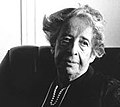
|
| Karen Blixen | Isak Dinesen | 1885 | Denmark | Writer and coffee farmer in Kenya for 17 years . One of her best known works is the autobiographical novel Out of Africa . |

|
| Karen Horney | Karen Horney | 1885 | German Empire , United States | Psychoanalyst and representative of neo- psychoanalysis . |

|
| Lorraine Hansberry | Lorraine Hansberry | 1930 | United States | Playwright and political activist. | |
| Mary Esther Harding | Mary Esther Karding | 1888 | United Kingdom , United States | Eminent Jungian psychoanalyst in the United States. | |
| Nelly Sachs | Nelly Sachs | 1891 | German Empire , Sweden | Jewish German - Swedish writer and poet . In 1966 the Nobel Prize Committee awarded her - together with Samuel Joseph Agnon - the Nobel Prize for Literature |

|
| Olive carpenter | Olive carpenter | 1855 | South Africa | Writer . She stood up for the oppressed and was best known as an early representative of the women's movement . |

|
| Rebecca West | Rebecca West | 1892 | United Kingdom | Writer and journalist . |

|
| Selma Lagerlöf | Selma Lagerlof | 1858 | Sweden | Swedish writer whose works are part of world literature . In 1909 she was the first woman to receive the Nobel Prize in Literature and in 1914 she was the first woman to be admitted to the Swedish Academy. |
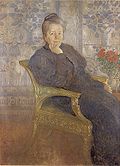
|
| Sigrid Undset | Sigrid Undset | 1882 | Norway | Novelist , novelist, lay Dominican and essayist. She received the Nobel Prize in Literature in 1928. |

|
| Simone de Beauvoir | Simone de Beauvoir | 1908 | France | Writer, philosopher and feminist . The politically committed author of numerous novels, short stories, essays and memoirs is considered a representative of existentialism . |

|
| Simone Weil | Simone Weil | 1909 | France | Philosopher , lecturer and teacher as well as social revolutionary of Jewish descent |
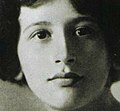
|
| Susanne K. Langer | Susanne Langer | 1895 | United States | Philosopher . She wrote one of the first introductions to modern symbolic logic . | |
| Vita Sackville-West | Vita Sackville-West | 1892 | United Kingdom | Writer and garden designer. She is also best known for her relationship with the writer Virginia Woolf . By marriage she later became Lady Nicolson . She received the Hawthornden Prize in 1933 . |

|
| Willa Cather | Willa Cather | 1873 | United States | Writer, received the Pulitzer Prize for the novel One of Ours in 1923 and enjoyed enormous acclaim with critics and audiences. |

|
- Individual evidence
- ↑ Brooklyn Museum: Virginia Woolf. In: brooklynmuseum.org. Retrieved November 3, 2019 .
Web links
- Brooklyn Museum, Virginia Woolf
- The Dinner Party on the website of Through the Flower , Judy Chicago's non-profit organization
